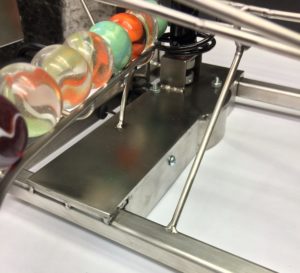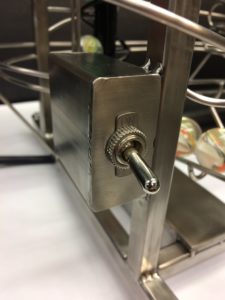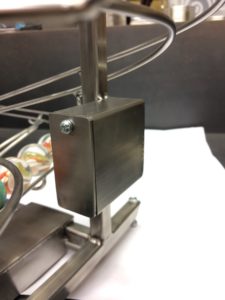While my sculptures are largely mechanically operated, some pieces do also employ electronics as well. I suppose that at times my artwork appears so complex and even chaotic that a person might think the electrical components are just as crazy, difficult, or possibly even dangerous. None of that is true, of course. I strive for safety, dependability and ease of maintenance with my electrical components and wiring. Electrically, my sculptures are easy to operate and as safe as any common household appliance.
Starting with safety, I use a grounded power cord for all of my sculptures to prevent any risk of electric shock. Wires running between switches and motors or other electronics is routed through the frame, out of sight. Connections for switches and motors are concealed inside enclosures that are secured by screws or other fasteners so as to be safe from casual, unwarranted interference, but easily accessible with simple tools. I source my parts from reputable retailers so that repair and replacement is simple, should that ever be necessary.

The enclosure at the base of this rolling ball sculpture houses the motor for the lift plus the main power wiring and switch wiring, making things safer and more pleasing to the eye. Electronics can be accessed from underneath via a cover plate attached with screws.
Providing power to the rolling ball sculpture is as simple as plugging it into a wall outlet. To bring it to life, you only need flip the power switch. The most common is the standard toggle switch, operating with an up/down flip like a wall outlet.

This is a toggle style power switch. The enclosure is welded to the sculpture. The wires travel through an access hole in the side of the enclosure into a corresponding hole in the frame of the sculpture itself, concealing them for safety and improved aesthetics.

Access to the power switch for the rolling ball sculpture is on the back side. Wiring is safely concealed from curious fingers, but easily accessed with a screwdriver.
However, let’s say you only want the sculpture to run for a few minutes at a time when a visitor requests it. In that case, a push button can be paired with a timer so that the sculpture comes on for a set amount of time and then automatically shuts off until the button is pressed again.
Let’s take the above scenario one step further. What if you want to locate your sculpture in the lobby of your pediatric dentistry, or a children’s hospital, or a library, but you want people to be able to interact with it? Under those circumstances, we can use a light sensor instead of a physical switch. All the viewer needs to do his wave his or her hand in front of the sensor and the sculpture will run for the specified period of time while remaining safe within its display. In this way, people would be free to interact with the sculpture, yet it would never be subject to distress or damage.
If you would like to be able to change the mood of the sculpture to fit your own. I can pair a rotary switch with a speed control so that you can influence the overall activity of your rolling ball sculpture, taking it from contemplative to energetic, as you please.
Do you have any other questions about my sculpture that I’ve not covered here or in another post? Click here and send me an email through my contact form. I’ll be happy to help you out.


